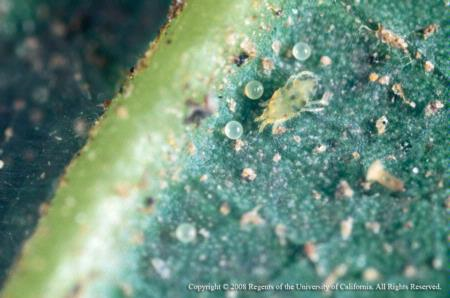Persea Mites
By Polly Nelson UCCE Master Gardener
What are the silky spots on the back side of my avocado leaves? F.B., Arroyo Grande
Persea mites (PM) cause spots to form on the underside of the leaves of avocado tree. Classic damage presents as distinct circular, yellow or brown spots along veins on the undersides of leaves, and the mites feed under dense silvery, silken patches. The spots become visible through the upper leaf surface as their numbers increase. Avocado Brown mites and Sixspotted spider mites can also feed on avocado leaves; the former mainly on the upper leaf surface, causing the upper leaf to appear bronzed or scorched, and damage is not in circular spots. Sixspotted spider mite damage is primarily on the underside of leaves and produces brown to purplish irregularly-shaped blotches along the veins, not distinct circular spots.
Persea mites (Family Tetranychidae) are yellow to green with two or more dark spots on its body. Adults have eight legs (six in the nymph stage). Each female lays 2 to 4 dozen round, pale yellow eggs in her lifetime; egg to adult development time is 2-3 weeks during temperatures of 63°-77°F. Densities of mites are lowest around March and gradually increase through spring as they feed on new leaf growth. Populations peak in July and August, but are suppressed when humidity is low and the daily high temperature is 100°F or greater for several consecutive days.
Persea mites are most damaging to Hass, Gwen, and a few other avocado varieties. Bacon, Fuerte, Lamb Hass, and Zutano varieties are much less affected.
High PM numbers can severely stress trees and cause premature leaf drop and defoliation, which results in sunburned bark, dropped fruit, and reduced yields. Lessen the effects of persea mites by maintaining healthy trees. Avoid over-watering and over-fertilizing. Avocado trees are susceptible to root rot diseases, a problem that is exacerbated by improper watering practices. Excess nitrogen will promote leaf flush and attract more mites. In the home garden, low numbers of mites can be tolerated without causing detrimental affects to otherwise healthy trees. If numbers get too high, washing the leaves, especially the undersides, with a stronge stream from the garden hose, to remove mites and destroy nests. Insecticidal oil can be applied if water alone doesn't work, although it may not be practical with a large tree.
Additional information may be found at http://ipm.ucanr.edu/PMG/r8400211.html
Don't miss our 11th annual Tomato Extravaganza and Plant Sale on Saturday August 19, 10:00 to 2:00 p.m. at 2156 Sierra Way, San Luis Obispo.
